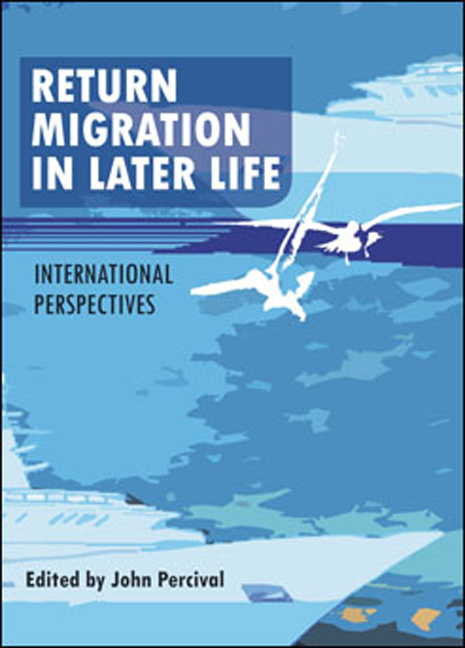Book contents
- Frontmatter
- Contents
- List of tables and figures
- Notes on contributors
- Acknowledgements
- one Charting the waters: return migration in later life
- two Older immigrants leaving Sweden
- three Place and residence attachments in Canada’s older population
- four Ageing immigrants and the question of return: new answers to an old dilemma?
- five Caribbean return migration in later life: family issues and transnational experiences as influential pre-retirement factors
- six ‘We belong to the land’: British immigrants in Australia contemplating or realising their return ‘home’ in later life
- seven Diasporic returns to the city: Anglo-Indian and Jewish visits to Calcutta in later life
- eight Returning to ‘roots’: Estonian-Australian child migrants visiting the homeland
- nine Ageing in the ancestral homeland: ethno-biographical reflections on return migration in later life
- ten ‘The past is a foreign country’: vulnerability to mental illness among return migrants
- eleven The blues of the ageing retornados: narratives on the return to Chile
- twelve Concluding reflections
- Endnotes
- Index
three - Place and residence attachments in Canada’s older population
Published online by Cambridge University Press: 01 February 2022
- Frontmatter
- Contents
- List of tables and figures
- Notes on contributors
- Acknowledgements
- one Charting the waters: return migration in later life
- two Older immigrants leaving Sweden
- three Place and residence attachments in Canada’s older population
- four Ageing immigrants and the question of return: new answers to an old dilemma?
- five Caribbean return migration in later life: family issues and transnational experiences as influential pre-retirement factors
- six ‘We belong to the land’: British immigrants in Australia contemplating or realising their return ‘home’ in later life
- seven Diasporic returns to the city: Anglo-Indian and Jewish visits to Calcutta in later life
- eight Returning to ‘roots’: Estonian-Australian child migrants visiting the homeland
- nine Ageing in the ancestral homeland: ethno-biographical reflections on return migration in later life
- ten ‘The past is a foreign country’: vulnerability to mental illness among return migrants
- eleven The blues of the ageing retornados: narratives on the return to Chile
- twelve Concluding reflections
- Endnotes
- Index
Summary
Introduction
Over the past two decades, the literature associated with migration in the context of older people has provided increasing detail regarding motivations for migrations, spatial patterns and migration propensities within this age group. Among older people, motivations often include amenity-oriented migration among the ‘young old’ at the time of retirement or shortly afterward (Longino, 1979; Litwack and Longino, 1987), kin-oriented migrations, such as the return of African Americans from the north to the south (Stack, 1996), and migrations associated with dependency or health needs as individuals age (Longino and Serow, 1992; Hayward, 2000; Hayward and Lazarowich, 2001). Amenity or ‘lifestyle’ migrations tend to be more prevalent among the healthy, the ‘young old’, and those with greater disposable income. These migrations are often concurrent with retirement, motivated by amenities, cost of living, or housing considerations (Kupiszewski et al, 2001a, 2001b).
Retirement destinations typically dominate the spatial patterns of return migration, particularly in the United States, where older migration flows tend to be more ‘channelised’, focusing on a few key retirement states in the American West or Southeast, including the ever-popular Florida and Arizona (Longino, 1995). In Europe, popular destinations include the south of France and Spain. Although such spatial focusing is less visible in Canada, the western-most province of British Columbia is an important retirement destination, and smaller sub-provincial units across the country have become retirement destinations, in large part because of their amenities and scenic locations (see, for example, Shearmur and Polèse, 2005).
Embedded within these broader discussions of older migrations are return migrations (those migrations returning an individual to an earlier place of residence) and onward migrations (subsequent migrations that do not return an individual to their previous place of residence). Previous literature has established the importance of these types of migration as components of migration streams (Long, 1988; Newbold, 1996). While research has illuminated general age-related patterns, including variations in the age profiles of return and onward migrations, the literature has not typically focused on the older population specifically. Clearly, it is unreasonable to assume that return and onward migration of older people mirror those of labour-forced aged migrants. Moreover, much of this literature is based on returns to an individual's place of birth (see, for example, Long, 1988; Newbold and Liaw, 1994).
- Type
- Chapter
- Information
- Return Migration in Later LifeInternational Perspectives, pp. 43 - 66Publisher: Bristol University PressPrint publication year: 2013
- 1
- Cited by



